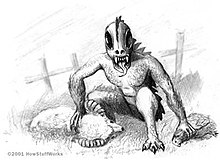Chupacabra
In Puerto Rico and in Hispanic America it is generally described as a heavy creature, reptilian and alien-like, roughly the size of a small bear, and with a row of spines reaching from the neck to the base of the tail, while in the Southwestern United States it is depicted as more dog-like.The name is attributed to Puerto Rican comedian Silverio Pérez, who coined the label in 1995 while commenting on the attacks as a San Juan radio deejay.[7] In 2019 a video recorded by Mundo Ovni showed the results of a supposed attack on chickens in the Seburuquillo sector of Lares, Puerto Rico.[8] A five-year investigation by Benjamin Radford, documented in his 2011 book Tracking the Chupacabra, concluded that the description given by the original eyewitness in Puerto Rico, Madelyne Tolentino, was based on the creature Sil in the 1995 science-fiction horror film Species.[9] Radford revealed that Tolentino "believed that the creatures and events she saw in Species were happening in reality in Puerto Rico at the time", and therefore concludes that "the most important chupacabra description cannot be trusted".Dr. David Morales, a Puerto Rican veterinarian with the Department of Agriculture, analyzed 300 reported victims of the chupacabra and found that they had not been bled dry.[14] The most common description of the chupacabra is that of a reptile-like creature, said to have leathery or scaly greenish-gray skin and sharp spines or quills running down its back.Thus, the same theory can be applied to many of the other 'chupacabra' attacks: that the dry weather had created a more competitive environment for native predators, leading them to prey on livestock to survive.A very likely explanation for this phenomenon is that individuals who had heard of the newly popular chupacabra had the creature's name fresh in their mind before they happened to see a strange looking animal.For example, some scientists hypothesize that what many believe to be a chupacabra is a wild or domestic dog affected by mange, a disease causing a thick buildup of skin and hair loss.


Chupacabra (disambiguation)ParanormalAstral projectionAstrologyBilocationBreatharianismClairvoyanceClose encounterCold spotCrystal gazingConjurationCryptozoologyDemonic possessionDemonologyDoppelgängerEctoplasmElectronic voice phenomenonExorcismExtrasensory perceptionForteanaFortune-tellingGhost huntingHaunted locationsMediumshipMiracleOccultParanormal fictionParanormal televisionPrecognitionPreternaturalPsychicPsychic readingPsychometryReincarnationRemote viewingRetrocognitionSpirit photographySpirit possessionSpirit worldSpiritualismStone TapeSupernaturalTelekinesisTelepathyTable-turningUfologySkepticismCold readingCommittee for Skeptical InquiryDebunkingJames Randi Educational FoundationMagical thinkingPrizes for evidence of the paranormalPseudoskepticismScientific literacyScientific skepticismParapsychologyAnomalous experiencesApparitional experiencesEmpathFalse awakeningHypnosisIdeomotor phenomenonOut-of-body experiencesSynchronicityAnomalisticsArgument from ignoranceArgumentum ad populumBandwagon effectBegging the questionCognitive dissonanceCommunal reinforcementFallacyFalsifiabilityFringe scienceGroupthinkJunk scienceProtosciencePseudoscienceScientific evidenceScientific methodSuperstitionUncertaintyUrban legendSpanishcryptiddrink the bloodPuerto RicoHispanic AmericaSouthwestern United StatesSouthern United StatescanidsregularizationSilverio PérezSan Juanradio deejaySatanicCanóvanasPuerto RicanLares, Puerto RicoBenjamin RadfordTracking the ChupacabraSpeciesnecropsyLatin AmericacoyotesUniversity of MichiganSarcoptes scabieiinternal bleedingcirculatory shockcanine teethcarnivoresMexican hairless dogsreptilekangarooYucatán PeninsulaMexicoUnited StatesBrazilMexicandroughtslivestockpredatorsdroughtweatherRadford's